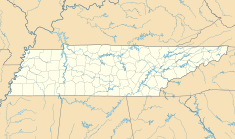Old Hickory Lock and Dam facts for kids
Quick facts for kids Old Hickory Lock and Dam |
|
|---|---|

The Old Hickory Lock and Dam forms Old Hickory Lake.
|
|
|
Location of Old Hickory Lock and Dam in Tennessee
|
|
| Country | US |
| Coordinates | 36°17′48″N 86°39′20″W / 36.29667°N 86.65556°W |
| Purpose | Flood, Navigation, Power |
| Status | Operational |
| Construction began | January 1952 |
| Opening date | December 1957 |
| Owner(s) | USACE |
| Dam and spillways | |
| Spillways | 6 |
| Reservoir | |
| Creates | Old Hickory Lake |
| Total capacity | 467,000 acre⋅ft (0.576 km3) |
| Catchment area | 11,674 sq mi (30,240 km2) |
| Surface area | 22,500 acres (9,100 ha) |
| Maximum length | 97.3 mi (156.6 km) |
The Old Hickory Lock and Dam is a large dam in middle Tennessee. It sits on the Cumberland River, about 25 miles (40 km) upstream from Nashville. This important structure helps control floods, allows boats to travel, and creates electricity.
Behind the dam is a big artificial lake called Old Hickory Lake. The dam and lake are named after President Andrew Jackson. He was nicknamed "Old Hickory" and lived nearby at The Hermitage.
Contents
Building the Dam
The Old Hickory Lock and Dam was planned as part of a big project for the Cumberland River. This project aimed to help with flood control and river travel. The U.S. Army Corps of Engineers designed the dam. Private companies built it under their watch.
Construction began in January 1952. The dam was finished enough to hold water by June 1954. The entire project was fully ready by December 1957. This is when the last part for making hydroelectric power started working.
Old Hickory Lake: The Reservoir
Old Hickory Lake is the reservoir formed by the dam. It stretches for about 97.3 miles (156.6 km) between Nashville and Carthage. This lake is mostly a "run-of-river" type. This means it lets the river flow through it most of the time.
The lake can hold some extra water to help control floods. It also stores water for making electricity and for boats to pass through the lock. Having the dam helps keep the river's water cleaner. It also provides good water for homes and businesses downstream. Because the lake's water level stays fairly steady, it's great for outdoor activities and protecting nature.
How the Dam Works
The U.S. Army Corps of Engineers manages the lock, dam, power plant, and lake. They make sure everything runs smoothly.
The Lock
The lock is like a water elevator for boats. It allows barges and recreational boats to move up and down the Cumberland River. This helps them get past the dam.
Making Power and Controlling Floods
The power plant uses as much river water as possible to make electricity. When there's a lot of water in the river, special gates called spillway gates open. These gates let out the extra water that the turbines can't use. They also help control floodwaters.
The dam can hold back extra water in the reservoir to prevent flooding. This is done by slowly raising all the spillway gates. This allows some water to pass under them. But it also holds back a lot of the incoming water. This helps protect areas downstream from floods.
The 2010 Floods
The Old Hickory Dam played a very important role during the big flooding on the Cumberland River in 2010. This flood happened after 13.5 inches (340 mm) of rain fell in just two days. How the dam was operated during this time became a big topic.
The Cheatham Dam, which is downstream from Nashville, was so flooded that its gates were opened completely. This allowed the river to flow freely over it. But Old Hickory Dam was not designed to have water flow over its top. So, preventing the reservoir from overflowing the dam was a top priority. The river upstream finally stopped rising when the reservoir was about one foot below the top of the dam.
Before the flood, Old Hickory Dam was releasing about 32,000 cubic feet per second (910 m3/s) of water. At the peak of the flood, the dam released a record flow of over 212,260 cubic feet per second (6,011 m3/s) of water. This shows how much water the dam helped manage during the crisis.
![]() This article incorporates public domain material from websites or documents of the United States Army Corps of Engineers.
This article incorporates public domain material from websites or documents of the United States Army Corps of Engineers.


